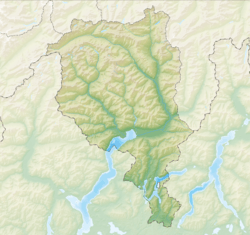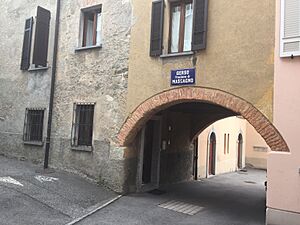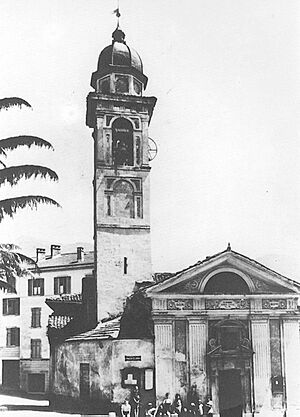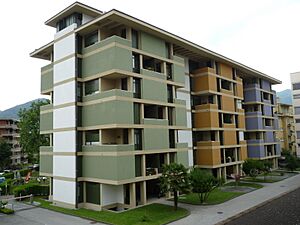Massagno facts for kids
Quick facts for kids
Massagno
|
||
|---|---|---|
|
||
| Country | Switzerland | |
| Canton | Ticino | |
| District | Lugano | |
| Area | ||
| • Total | 0.74 km2 (0.29 sq mi) | |
| Elevation | 352 m (1,155 ft) | |
| Population
(Dec 2020 )
|
||
| • Total | 6,272 | |
| • Density | 8,480/km2 (21,950/sq mi) | |
| Postal code |
6900, 6908
|
|
| Surrounded by | Lugano, Savosa | |
| Twin towns | Onex (Switzerland) | |
Massagno is a town in the Lugano area, located in the Ticino region of Switzerland. It's a place with a rich history and a growing population.
Contents
History of Massagno
The earliest signs of people living in Massagno are very old! An axe made from a type of rock called serpentinite was found, dating back to the Upper Paleolithic period (the late Stone Age). Some ancient burial sites from the Iron Age have also been discovered.
The village of Massagno was first written about in 1146. Back then, it was called Masagnio. Later, in 1198, it was known as Maxanio.
During the Middle Ages, Massagno and a nearby settlement called Gerso formed a community known as a Vicinanza. This community was part of the larger Lugano area. Important churches and landowners, like the Cathedral of S. Lorenzo in Lugano, owned land here.
Massagno was historically part of Lugano's main church area. A chapel dedicated to St. Anthony of Padua in Gerso was built between 1655 and 1670. It was paid for by a local family who became rich trading wool in Venice.
In the early 1800s, a main road was built into the village. Later, between 1879 and 1880, a railway line was being built. This brought many workers, especially from Italy, to Massagno, causing the town to grow a lot! Today, many people who live in Massagno travel to other towns for work.
Massagno's Geography
Massagno is a small area, about 0.74 square kilometers (which is less than half a square mile). Most of this land (about 98.6%) is covered by buildings and roads. Only a tiny part (1.4%) is forest.
The town is located in the Lugano area, just north-west of the city of Lugano. It includes the main village of Massagno, the settlement of Gerso, and since 1804, a part of what used to be the town of Rovello.
Massagno's Coat of Arms
The coat of arms for Massagno is a blue shield with a green chestnut tree on a hill. The tree has red fruits and golden roots. Above the tree, there's a shining sun, and at the bottom, there are two wavy silver lines.
The chestnut tree on the coat of arms shows that the town is on a hill surrounded by chestnut trees.
People and Population
Massagno has a population of about 6,195 people (as of 2016). Many people living here are from other countries, with a large number born in Italy.
Most people in Massagno speak Italian (about 78%). German is the second most common language, and Serbo-Croatian is third.
In 2016, about 17.7% of the population were children and teenagers (0–19 years old). Adults (20–64 years old) made up 60.8%, and seniors (over 64 years old) were 21.5%.
Most homes in Massagno are apartments or multi-family buildings, rather than single-family houses.
The chart below shows how Massagno's population has grown over time:

Getting Around Massagno
Massagno is very well connected for travel! It's close to the Lugano train station, which is on the important Gotthard railway line. This line connects cities like Zurich and Milan.
New tunnels, like the Gotthard Base Tunnel (opened in 2018) and the Ceneri Base Tunnel (opened in 2020), have made train travel even faster. For example, the travel time between Locarno and Lugano has been cut from 55 minutes to just 22 minutes!
There are plans to fill in the "trincea" (a ditch where the railway tracks run) in Massagno and turn it into a park.
Massagno is also right next to the Lugano-South exit of the Swiss Highway 2, which is another major route from Basel to Milan.
In the past, there was a narrow-gauge railway called the Lugano–Tesserete railway that connected Lugano to Tesserete, with a stop in Massagno. This railway started in 1907 but was replaced by a bus line in 1967.
Important Buildings and Heritage Sites
Massagno has some interesting historical buildings:
- Parish church of Santa Lucia: This church has beautiful old paintings from the 16th and 17th centuries, including "Adoration of the Magi" and "Annunciation." It also has stained glass windows. These paintings originally came from an even older church built in 1530.
- The D’Appartamenti Albairone House: This apartment building, designed by architect Peppo Brivio, is considered a very important heritage site in Switzerland.
Massagno's Economy
Massagno is a community where many people live but often work in nearby Lugano. Most jobs in Massagno are in the tertiary sector, which means jobs in services like shops, offices, and hotels. There are also some jobs in the secondary sector, which includes manufacturing and construction. There are no jobs in the primary sector (like farming) in Massagno.
In 2009, Massagno had 3 hotels with a total of 34 rooms.
Religion in Massagno
According to a census from 2000, most people in Massagno (about 69%) are Roman Catholic. About 6.5% belong to the Swiss Reformed Church.
Education in Massagno
Switzerland is known for its good education system, and Massagno is no exception. Many adults in Massagno have completed higher education.
In Massagno, there are schools for all ages:
- Kindergarten: Children can attend non-mandatory kindergarten for up to three years.
- Primary School: This program lasts for five years.
- Lower Secondary School: After primary school, students can choose between a two-year middle school followed by a pre-apprenticeship, or a four-year program to prepare for university.
- Upper Secondary School: This level prepares students for a trade job or for university. Students can attend school full-time or part-time while also doing an internship or apprenticeship.
- Professional Program: This three-year program prepares students for jobs in fields like engineering, nursing, computer science, and tourism.
Many students who live in Massagno attend schools in other towns, and some students from other towns come to Massagno for school.
See also
 In Spanish: Massagno para niños
In Spanish: Massagno para niños










